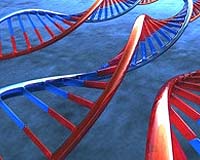| . |  |
. |
Moffett Field CA (SPX) Aug 13, 2009 A new study shows that new species of life on Earth emerge just as often as they die out, and that most evolution occurs in small bursts. The research has implications in understanding the history of life on our planet and the evolutionary processes that will shape the biosphere's future on Earth. In a paper published in the Proceedings of the National Academy of Sciences online early edition, Luke Harmon, professor of biological sciences at the University of Idaho, worked with a research team led by Michael Alfaro, UCLA assistant professor of ecology and evolution biology, to analyze the evolution of the 60,000 species of jawed vertebrates using genetic data. We wanted to see how much information we could get about speciation and extinction when we don't have much direct information from the fossil record," said Harmon, who led the effort to analyze the data. "It's a really useful thing to do because the fossil record is incomplete in some times and places, and for certain groups." The researchers scoured records for genetic data on all of the species of jawed vertebrates, which includes everything from sharks to birds. They used that data to create an evolutionary tree that maps which species are closely related and when they diverged from a common ancestor. Once that was accomplished, a computer program determined how close different models of speciation and extinction fit the facts. The research team found that the best-fit system features an extinction rate nearly identical to the rate of new species being formed. Similar studies in the past had left scientists puzzled because the models often left no room for extinction at all. However, those studies typically involved less than 100 species, instead of the 60,000 used in the research published in PNAS. The group also found that the data support distinct rates of speciation and extinction among major groups of animals during different periods of time. Out of all of the taxonomic groups, nine stood out. "Neoaves - most modern birds - and percomorphs - fish related to perch - are very diverse given their age," said Harmon. "In fact, if you add up the numbers of these and other unusually diverse groups then you find that most of the jawed vertebrate species on Earth are the result of explosive, young radiations." On the other end of the scale, the study identified several "living fossils" that have been around for hundreds of millions of years, but have very few species. One example is the Tuatara, a 200 million-year-old order containing only two species that today are found only on remote islands in New Zealand. Though they resemble lizards, they are actually very distantly related to all living species of lizards and snakes. Another oddity is the crocodilian family, which consists of crocodiles and alligators. "Crocodiles have been around for over 200 million years, but there are only 23 species of them now," said Harmon. "Given their age, there should be more. This implies that, just like there are processes that can elevate the rates of speciation and extinction, there must be some kind of process that can depress them as well. "These ancient animals that have neither speciated nor become extinct are a real paradox in macroevolution. We still don't know how to explain these groups' persistence over long periods of time." The research manuscript titled "Nine Exceptional Radiations Plus High Turnover Explain Species Diversity in Jawed Vertebrates" can be found in the PNAS Early Edition by searching tracking number 2008-11087RR at www.pnas.org. Share This Article With Planet Earth
Related Links University of Idaho Explore The Early Earth at TerraDaily.com
 Minute DNA change could lead to evolution
Minute DNA change could lead to evolutionCambridge, England (UPI) Aug 5, 2009 One tiny change in DNA could lead to the evolution of a new species, an English researcher reported. A team lead by a University of Cambridge scientist explored this possibility when they studied two closely related flycatcher populations in the Solomon Islands, reporting their results in the American Naturalists. The scientists said they studied two sub-species with the same bod ... read more |
|
| The content herein, unless otherwise known to be public domain, are Copyright 1995-2009 - SpaceDaily. AFP and UPI Wire Stories are copyright Agence France-Presse and United Press International. ESA Portal Reports are copyright European Space Agency. All NASA sourced material is public domain. Additional copyrights may apply in whole or part to other bona fide parties. Advertising does not imply endorsement,agreement or approval of any opinions, statements or information provided by SpaceDaily on any Web page published or hosted by SpaceDaily. Privacy Statement |